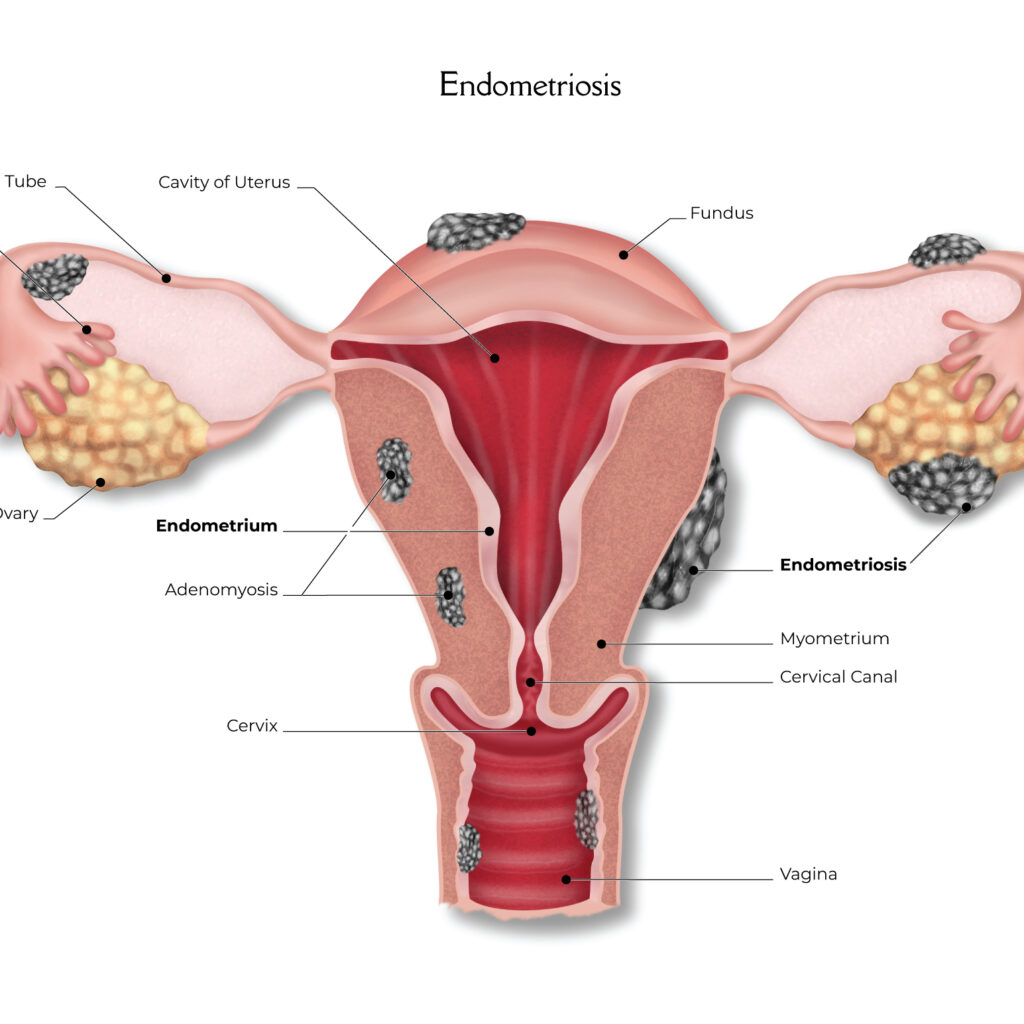As a renowned expert in managing severe, multi-organ endometriosis, Dr. Farr Nezhat isn’t just one of the best endometriosis specialists in New York City, he’s also among the most prominent in the world. He’s frequently invited to speak at important medical conferences, and patients travel across the globe to experience his pioneering treatment.
What is endometriosis?
Endometriosis is a chronic, progressive, estrogen-dependent inflammatory disease. It is defined as the presence of endometrial-like cells, similar to those lining the inside of the uterus, in other areas of the body. It is most commonly found in the pelvic cavity on the uterus, fallopian tubes and ovaries, but it is frequently found in extra-genital areas such as the bowel, bladder, and ureters, and is known to affect the diaphragm, lungs, and many other organs and locations.
It is estimated that at least 11% of women have endometriosis.
There is no definitive cure for endometriosis but it can be effectively managed medically and surgically.
What are the symptoms of endometriosis?
- Pain. Symptoms vary widely, but the most common one is pelvic pain that can range from mild to debilitating. Pain most frequently occurs around the time of menstruation but depending on the location of the disease pain can occur anytime throughout the month. Pain can also be present during intercourse, bowel movements or urination, or manifest as back pain.
- Menstrual cramps are not normal and are an indication that endometriosis should be ruled out by a physician well versed in treating endometriosis.
- Infertility. Approximately 40 percent of women with endometriosis experience infertility and approximately 40 percent of all women with infertility have endometriosis.
- Abnormal bleeding between menstrual periods
- Gastrointestinal issues such as constipation, diarrhea, bloating or nausea
What causes endometriosis?
There are many hypotheses as to what causes endometriosis but none of them have been definitively proven nor do they fully explain disease development. It is thought to be multifactorial, involving:
- Retrograde menstruation
- Lymphatic and hematogenous spread
- Genetic predisposition and abnormal gene expression
- Environmental factors
- Immune system dysfunction.
Endometriosis implants respond to monthly fluctuations of female sex hormones and proliferate by bleeding and implanting elsewhere, causing scar tissue and adhesions in a vicious cyclic fashion.
How is endometriosis diagnosed?
Currently, the best-accepted way to diagnose endometriosis is by laparoscopy, a minimally invasive surgical procedure, to visualize and biopsy suspicious lesions, which are then confirmed by microscopic evaluation. There is not yet a non-invasive diagnostic test for endometriosis. Endometriosis commonly goes undiagnosed or is misdiagnosed and it typically takes 6 to 10 years from the time a woman experiences her first symptoms to the time she receives a diagnosis.
What are the risk factors for endometriosis?
Endometriosis is predominately found in women of reproductive age, but it also affects teenage girls who have not yet menstruated, post-menopausal women, and women who have had their uterus or ovaries removed.
- Prolonged estrogen exposure
- Beginning menstruation at an early age
- Having frequent or long-lasting periods
- Heavy menstrual bleeding
- Not having had children
- Congenital genital anomalies
What treatment options does Dr. Nezhat offer for endometriosis?
Medical Management
Pain relievers and hormonal treatments can be effective at lessening symptoms, but side effects can be problematic, and they do not stop the progression of disease.
- Non-steroidal anti-inflammatories (NSAID’s)
- Oral contraceptive pills
- Androgens
- Progestins
- GnRH agonists and antagonists
- Aromatase inhibitors
Surgical Management
The standard of care is to perform minimally invasive surgery to destroy endometriosis implants by coagulation (burning), ablation (vaporization) and resection (excision). The goal is to restore normal anatomy and organ function, to reduce pain, and to preserve fertility. In experienced hands, the benefits of surgery outweigh the risks.
Many of Dr. Nezhat’s surgical breakthroughs arose from treating patients with extensive endometriosis. This work was compiled in a textbook covering the medical and surgical management of endometriosis.
Endometriosis Q & A
Dr. Nezhat has published a textbook on the medical and surgical management of endometriosis and over 14 book chapters addressing endometriosis. Additionally, he has over 70 endometriosis-related publications attributed to him in PubMed.
Endometriosis – Ask the Experts
A monthly livestream Q&A discussing current and ongoing research on endometriosis. To subscribe, go to https://www.youtube.com/c/WorldwideEndoMarch
Endo Explained: Ask the Experts | Social and Psychological Impact of Endometriosis (ep. 18)
Endo Explained: Ask the Experts | Ovarian Endometriomas/Chocolate Cysts (ep. 17)
Endo Explained: Ask the Experts | What’s Next For Couples with Infertility and Failed IVF – Part 3 (ep. 16)
Endo Explained: Ask the Experts | What’s Next For Couples with Infertility and Failed IVF – Part 2 (ep. 15)
Endo Explained: Ask the Experts | What’s Next For Couples with Infertility and Failed IVF – Part 1 (ep. 14)
Endo Explained: Ask the Experts | Current Research on Endometriosis (ep. 13)
Endo Explained: Ask the Experts | Ovarian Endometriomas and Chocolate Cysts (ep. 12)
Endo Explained: Ask the Experts | Call to Action on Early Detection of Endometriosis (ep. 11)
Endo Explained: Ask the Experts | Challenges Facing Parents of Adolescents with Endo (ep. 10)
Endo Explained: Ask The Experts | Myths and Misconceptions (ep. 9)
Endo Explained: Ask The Experts | Endometriosis in Teenagers (ep. 8)
Endo Explained: Ask the Experts | Thoracic Endometriosis Syndrome (ep. 7)
Endo Explained: Ask the Experts | Alternative Therapies for Endometriosis (ep. 6)
Endo Explained: Ask the Experts | Myoma, Adenomyosis, and Endometriosis (ep. 5)
Endo Explained: Ask the Experts | Chocolate Cyst, Endometrioma, Bladder & Ureter Endo (ep. 4)
Endo Explained: Ask the Experts | Ep. 3 – Bowel Endometriosis
Endo Explained: Ask the Experts | Ep. 2 – Infertility & Endometriosis
Endo Explained: Ask the Experts | Ep. 1 – Endometriosis & Pain
A listing of over 226 of Dr. Nezhat’s research articles can be found at the PubMed search engine, which pulls references and abstracts from the U.S. National Library of Medicine (NLM) database maintained at the National Institutes of Health (NIH).

